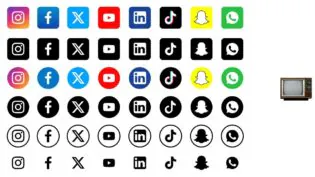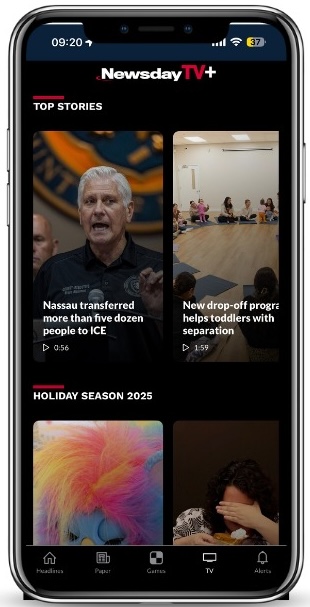It’s the end of 2025 and vertical video is here to stay.
 Right around this time last year, I talked to several news publishers launching vertical video on their own platforms. They started out experimenting with vertical video on social, saw high engagement there, and wanted to bring that engagement to their own sites.
Right around this time last year, I talked to several news publishers launching vertical video on their own platforms. They started out experimenting with vertical video on social, saw high engagement there, and wanted to bring that engagement to their own sites.
 Nearly three-quarters of Americans watch news videos online and most of them (61%) use social media or YouTube to do so. This year, The Economist, Newsday, The New York Times, The Washington Post, and CNN all launched dedicated tabs for video viewing in their apps, to try to keep some of those users on their own sites.
Nearly three-quarters of Americans watch news videos online and most of them (61%) use social media or YouTube to do so. This year, The Economist, Newsday, The New York Times, The Washington Post, and CNN all launched dedicated tabs for video viewing in their apps, to try to keep some of those users on their own sites.
“If we are seeing a migration of our existing audience over to a new format, we still want them to get information from Newsday,” TC McCarthy, Newsday’s VP of digital development, told me. “We do this job because it’s important to have an informed populace. So let’s try to be where they are.”
The New York Times’ Watch tab begins autoplaying video as soon as you tap it. The Economist lets users toggle between short vertical videos and Insider, the magazine’s recently launched, twice-weekly, horizontal discussion show. Newsday’s TV tab leads with live news programming filmed in its studio, followed by topic-based video carousels. Newsday and The New York Times both include the corresponding story link with every video.
This isn’t the infamous “pivot to video” of the 2010s, when publishers rushed to create Facebook news video teams, only to find nobody was watching. The publications I spoke to for this story are doubling down on news video on their own platforms, while also publishing vertical video to social media.
“We always want to make sure that we’re catering to all of our audience, and we don’t want to make them try all these different places to get the news the way they want to get it,” McCarthy said.
Everyone’s watching vertical video now
 Newsday integrated vertical video into its app in August, said Emilio Guerra, Newsday’s VP of digital content. Around 30% of users open it nearly every day. Most of Newday’s videos come in horizontal and vertical versions. About a third of the videos viewed across Newsday’s sites are vertical, Guerra said, and 25% of its vertical video views come from desktop devices, even though its overall traffic from desktop is less than 20%.
Newsday integrated vertical video into its app in August, said Emilio Guerra, Newsday’s VP of digital content. Around 30% of users open it nearly every day. Most of Newday’s videos come in horizontal and vertical versions. About a third of the videos viewed across Newsday’s sites are vertical, Guerra said, and 25% of its vertical video views come from desktop devices, even though its overall traffic from desktop is less than 20%.

Newsday’s TV tab
The Economist launched a dedicated video tab in its app in March. In-app video viewing is only available to paid subscribers, and vertical video consumption across the app — including in the tab — has more than doubled in the last year, head of video Liv Moloney told me.
Moloney pointed to a recent Economist piece about how older people’s screen time has skyrocketed. “The idea that it’s just young people [watching vertical video] is a bit misleading,” she said. “This is very anecdotal, but my dad sends me many more Instagram Reels than he did a few years ago.”
Just media, no social
While publishers’ video tabs and vertical videos are obviously inspired by social media, they generally don’t include social features like comments and likes. And they’re not powered by algorithms; if two different people open the tabs, they’ll see the same thing.
“We wanted to start with a basic experience that had the things we felt were most important,” said Solana Pyne, video director at The New York Times. “We’re not trying to be TikTok. Their primary goal is not to communicate information. It’s pure engagement.”

It’s not that the Times would never consider adding more social features to its videos, she said. “But what we wanted to see first was: What does it feel like to curate our distinctive journalism and get a sense for how our audience is engaging with it?”
Times editors curate all the videos you see in the Watch tab, choosing them from sections like news, opinion, The Athletic, Wirecutter, and Cooking.
“Our initial theory is people are coming to us for news, so we start with the urgent [stories], then our investigations, and then weave in a mix of coverage from across the entire company,” Pyne said. “We want to be able to catch you up at the top and give you an opportunity to explore the breadth of the videos that we’re making, and right now it feels like a really satisfying experience.” Personalization may come in the future, but there are no concrete plans for it yet.
The Economist and Newsday have carousels for different sections, and users can scroll through “playlists” of just news, sports, business, or lifestyle videos. “The Feed Me section doesn’t have crime stories, and vice versa,” Newsday’s McCarthy said. “The people who are best equipped and knowledgeable about the audiences for those sections are making regular decisions about what to put in a carousel and when. So far the [internal] discussion has been that people are doing this much better than an algorithm could right now.”
The publishers I spoke with haven’t enabled comments on vertical videos yet, in part because moderating comments is a lot of work. The Economist’s Moloney said that while having that kind of engagement can be great for building community, it’s not the publication’s best use of resources right now.

The Economist’s Shorts tab
McCarthy said he sees a case for adding some sort of “liking” feature to vertical videos in Newsday’s app, but the company needs to gauge the audience’s reaction to the current iteration of the tab first. “[Adding] he social features and then [backing] them with an algorithm is substantial tech investment,” McCarthy said. “[Doing] that from the outset wouldn’t make a lot of sense if the feature itself wasn’t getting a good response.”
Ad-free…for now
While The Economist’s entire app is only for subscribers, The New York Times and Newsday let users watch videos in their tabs without subscriptions. And the videos are free on social media.
Instagram hits me with an ad after I scroll through eight Reels. TikTok and Facebook Reels do so after three. Publishers know there’s money to be made from vertical video, and while none of the three video tabs currently have ads, that’s likely to change — at least at The New York Times — in the next few months.
The New York Times’ advertising department has been scaling up its own vertical video capabilities to match the newsroom’s increased output, said Joy Robins, the Times’ global chief advertising officer.
“The Watch tab is an exciting new placement for advertisers that adds a significant pillar to our full suite of video advertising offerings,” she told me in a statement. “Available for brands as part of an open beta test for vertical video advertising by early 2026, this new placement will offer brands a way to create video ads with speed and simplicity, making it easier than ever to get started and optimize campaigns.”
Newsday, meanwhile, is in the early stages of discussing Watch tab advertising. McCarthy said that for now, Newsday is “trying to make the video experience as uninterrupted as possible.” But advertisers are already familiar with the format and style, Guerra said, so it shouldn’t be a hard sell when the time comes.
The Economist’s video tab is part of its general strategy to make its subscription as enticing as possible. About two-thirds of the Economist Group’s revenue comes from subscriptions, with the remaining third comes from advertising. In June, Economist president Luke Bradley-Jones told me that the app had more than 270 million active visits for the year ending in March, up from 239 million the previous year, and that 85% of new subscribers were digital-only.
“Breadth of consumption is really important for subscribers to renew their subscription,” Moloney said. “Within the top-performing videos is the breadth of topics, like economics, geopolitics, fun videos, book recommendations. You can rarely see the same [topics]. It really is like another version of The Economist, but in a new form, which I think is really reassuring.”
